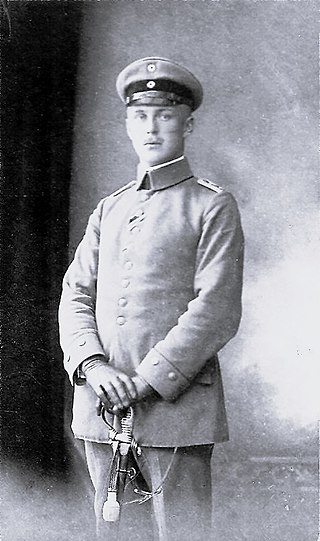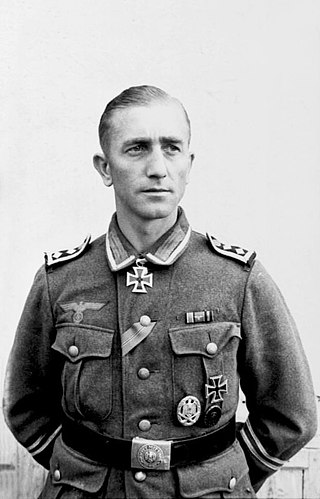Ranks of the Imperial German Army
Officer corps
Critics long believed that the Army's officer corps was heavily dominated by Junker aristocrats, so that commoners were shunted into low-prestige branches, such as the heavy artillery or supply. However, by the 1890s, the top ranks were opened to highly talented commoners. [1] [2]
General officers / Generäle
| Rank group | General Officers | |||||
|---|---|---|---|---|---|---|
| Insignia | |  | | |  |  |
| Rank designation | Generalfeldmarschall | Generaloberst mit dem Rang als Generalfeldmarschall | Generaloberst | General der Waffengattung | Generalleutnant | Generalmajor |
| (English designation) | General Field Marshal | Colonel General in the rank of Field Marshal | Colonel General | General of the branch | Lieutenant General | Major General |
Field officers / Stabsoffiziere
| Rank group | Staff Officers | ||
|---|---|---|---|
| insignia |  |  |  |
| Rank designation | Oberst | Oberstleutnant | Major |
| (English designation) | Colonel | Lieutenant Colonel | Major |
Captains and subalterns / Hauptleute und Subalternoffiziere
| Rank group | Subalterns | |||
|---|---|---|---|---|
| insignia |  |  |  |  |
| Rank designation | Hauptmann/Kapitän I Klasse: infantry and artillery Rittmeister I Klasse: cavalry | Hauptmann/Kapitän II Klasse: infantry and artillery Rittmeister II Klasse: cavalry | Oberleutnant Feuerwerksoberleutnant | Leutnant : infantry, cavalry and other arms Feuerwerksleutnant: artillery |
| (English designation) | Captain | Staff Captain [lower-alpha 1] | 1st Lieutenant | 2nd Lieutenant |
Warrant officers and officer cadets
- Cadet ( Fahnenjunker , ranking between Sergeant and Vizefeldwebel) – served as cadets in the various military academies and schools. After graduation, they became a Fähnrich.
- Ensign ( Fähnrich , ranking between Vize-Feldwebel and Feldwebel) A probationary officer waiting to become a 2nd Lieutenant (Leutnant).
- Deputy Officer ( Offizierstellvertreter , ranking above Etatmäßiger Feldwebel) A warrant officer usually used as a brevet Leutnant or an acting platoon leader.
- Uncommissioned Lieutenant (Feldwebelleutnant, a permanent rank as a junior 2nd Lieutenant with Lieutenant's pay, but without an officer's commission.) Usually used for staff work at the company level. They wore an officer's dress sword (degen) rather than an NCO's dagger. Still a member of the NCO's Mess until 1917, when he became eligible for the Officer's Mess.
Non-commissioned officers / Unteroffiziere
| Rank group | Unteroffizier mit Portepee | Unteroffizier ohne Portepee | ||
|---|---|---|---|---|
| Collar |  |  |  |  |
| Epaulette | ||||
| Title | Etatmäßiger feldwebel | Vizefeldwebel | Sergeant | Unteroffizier |
| Cavalry/ Artillery | Etatmäßiger wachtmeister | Vizewachtmeister | ||
- Unteroffizier mit Portepee ("Non-Commissioned Officer with Sword Knot"). Senior NCOs with the right to wear a ceremonial lanyard tied to the hilt of their NCO service dagger.
- Etatmäßiger Feldwebel ("Budgetary Sergeant-Major") A senior feldwebel who was on the regimental payroll. Nicknamed der Spiess ("the Pike"), they were equivalent to a British Regimental Sergeant Major.
- Feldwebel ("Sergeant-Major") A company's senior NCO. They were equivalent to a British Company Sergeant Major or an American First Sergeant.
- Vizefeldwebel ("Assistant Sergeant-Major") A platoon's senior NCO. They are equivalent to a British Staff Sergeant.
- Unteroffizier ohne Portepee ("Non-Commissioned Officer without Sword Knot"). Junior NCOs who did not have the right to wear the sword knot.
- Sergeant A junior NCO who leads a squad.
- Unteroffizier ("Subordinate Officer") A junior NCO who assisted the Sergeant in leading a squad. They are equivalent to a British or American Corporal.
Enlisted (Mannschaften/Gemeine) ranks
| Rank group | Enlisted | ||||
|---|---|---|---|---|---|
| Collar |  | ||||
| Epaulette | |||||
| Title | Kapitulant | Einjährig-freiwilliger | Obergefreiter | Gefreiter | Soldat |
| English designation | Capitulant | One-Year Volunteer Enlistee | Senior Lance Corporal | Lance Corporal | Private |
- Musketeer (Musketier, Prussian army infantry regiments), Infantryman (Infanterist, Bavarian army infantry regiments), Soldier (Soldatzüng, Saxon army infantry regiments), Gunner (Kanonier, foot artillery), Pioneer (Pionier, pioneer branch). Other unit-specific enlisted ranks were: Fusilier (Füsilier), Grenadier (Grenadier), Huntsman otherwise Light-Infantryman (Jäger), Dragoon (Dragoner), Hussar (Husar), Cuirassier (Kürassier), Uhlan (Ulan), Fusilier Guard (Garde-Füsilier), Grenadier Guard (Garde-Grenadier), Wehrmann (Landwehr), etc.
- Lance Corporal ( Gefreiter ); up until 1918 the only rank (with exception of Obergefreiter in the foot artillery) to which a conscripted soldier could be promoted. The rank was a deputy rank to the Corporal (Unteroffizier) [lower-alpha 2] rank. [4]
- Senior Lance Corporal ( Obergefreiter ); established in the Prussian Army from 1846 to 1853, reestablished in 1859, then in foot artillery only, replacing the artillery Bombardier rank that had been introduced in 1730. [4]
Additionally, the following voluntary enlistees were distinguished:
- One-Year Volunteer Enlistee (Einjährig-Freiwilliger): despite the name, one-year volunteers were actually conscripts who served a short-term form of active military service, open for enlistees up to the age of 25. Such enlisted soldiers were usually high school graduates ( Matura, Abitur ), who would opt to serve a one-year term rather than the regular two or three-year conscription term, with free selection of their chosen military service branch and unit, but throughout were obligated to equip and subsist themselves at entirely their own cost. In today's monetary value, this could at bare minimum cost some 10,000 euro, which purposely reserved this path open to sons from mostly affluent social class families wishing to pursue the Reserve-Officer path; it was the specific intention of Wilhelm II that such Reserve-Officer career path should only be open to members of so-called "officer-material" social classes. [5] On absolving their primary recruit training, those aspiring to become Reserve-Officers would have to qualify and achieve suitability for promotion to the Gefreiter rank and then would continue to receive further specialized instruction until the end of their one-year term, usually attaining and leaving as surplus Corporals (überzählige Unteroffiziere) (Reservists), with the opportunity to advance further as reservists. Enlistees who did not aspire to officer grade would leave at the end of their one-year term as Gemeine [lower-alpha 3] (Ordinary soldier) enlisted rank (for example Musketier or Infanterist) and a six-year reserve duty obligation. [5] Eligibility for this specific one-year path of military service was a privilege approved upon examining the enlistee's suitability and academic qualifications.
- Long-Term Volunteer Enlistee "Capitulant" (Kapitulant): enlisted soldiers who had already absolved their regular two or three-year military conscription term and had now volunteered to continue serving for further terms, minimum was 4 years, generally up to 12 years. [7] [lower-alpha 4]
Note: Einjährig-Freiwilliger and Kapitulant were not ranks as such during this specific period of use, but voluntary military enlistee designations. They, however, wore a specific uniform distinction (twisted wool piping along their shoulder epaulette edging for Einjährig-Freiwilliger, the Kapitulant a narrow band across their lower shoulder epaulette) in the colours of their respective nation state. This distinction was never removed throughout their military service nor during any rank grade advancements.































